By Emily Lee Stehle
Pieced & Patterned
Through January 23
Museum of Fine Arts St. Pete
Details here
When asked by Arts Coast Magazine to attend the press viewing of a quilt show, I jumped at the chance. As a new emerging artist specializing in weaving recycled paper sculptures and moving into flat pieces, I saw my first surprising connection to quilting very late – it was the moment my Ms. Blue aka the Blue Monster paper was installed and hung on a wall at the Creative Pinellas Gallery.
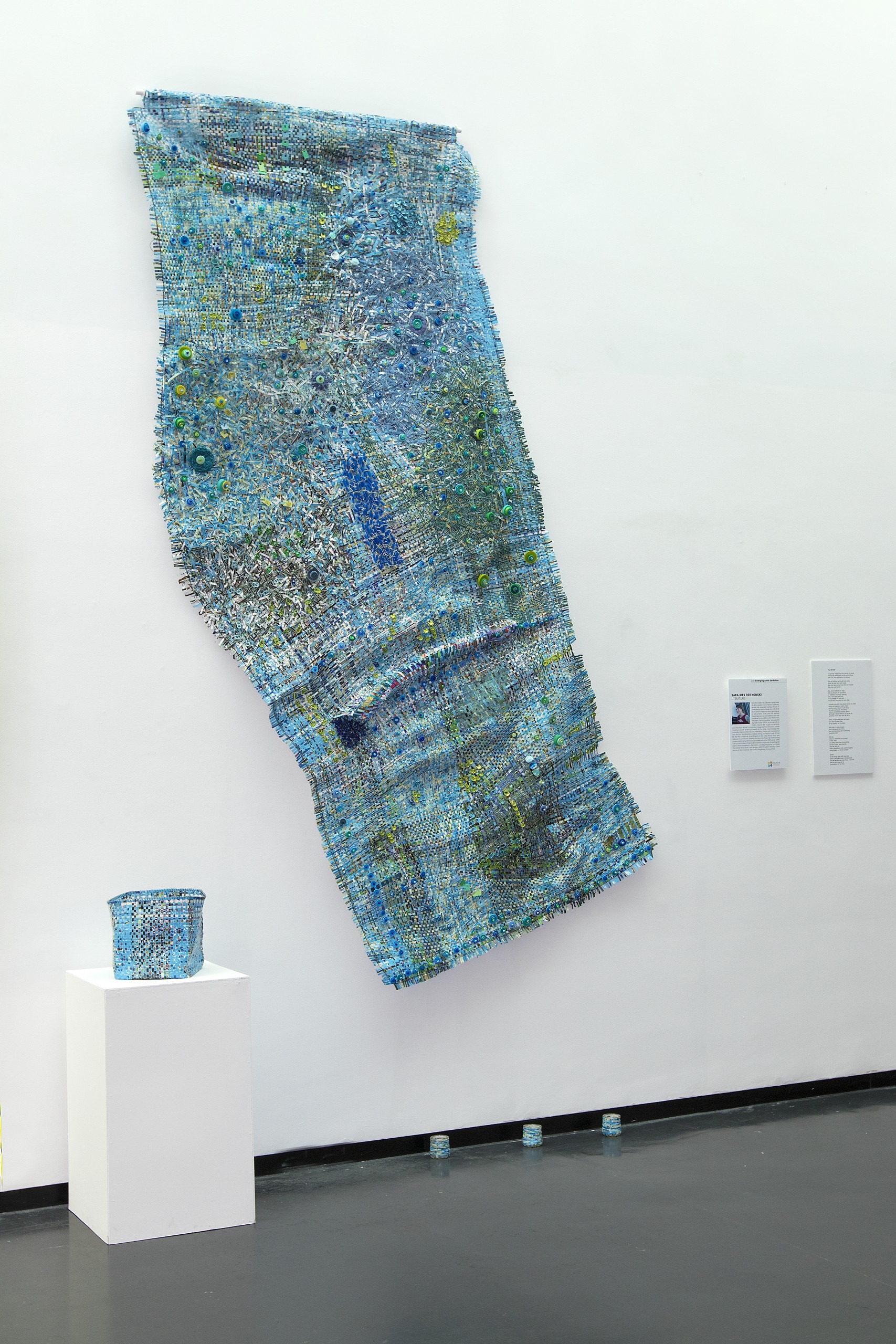
. . .
My Quilt Story – I love quilts. I have an entire two-foot long shelf devoted to quilt books and go to museums, art and quilt shows to see them. I love quilts not only for the comfort and homelife they represent but the stories and craftmanship of the maker.I love quilts so much I took an adult education quilting class years ago to make a table runner.
It was pieced out of turquoise, rust, black and white triangles, rectangles and squares and machine stitched. The top was entirely hand-quilted. I never finished it – I had missed the last class on binding, the final step of connecting the sides of the top and bottom with a stitched band of fabric. Twenty years later that unfinished piece went to my sister, a talented and award-winning quilter, who no longer actively quilts. Maybe she will finish it.
. . .
The Museum of Fine Arts in St. Petersburg is showing its first major – and unique – exhibit of 32 textiles drawn from private collections in Florida (three from the Tampa Bay area) and Tennessee, curated by MFA Senior Curator of Collections and Exhibitions Stanton Thomas, PhD and Assistant Curator Erin Wilson. It is indeed special not only for the rarity and age of the work. It is an example of traditional handicraft that over the years becomes recognized as fine craft or what the experts might call “high” art. It’s a stance the MFA fully supports.
Curator Thomas set up the tone of our tour with this statement, “What amazes me is they exist at all!”
. . .
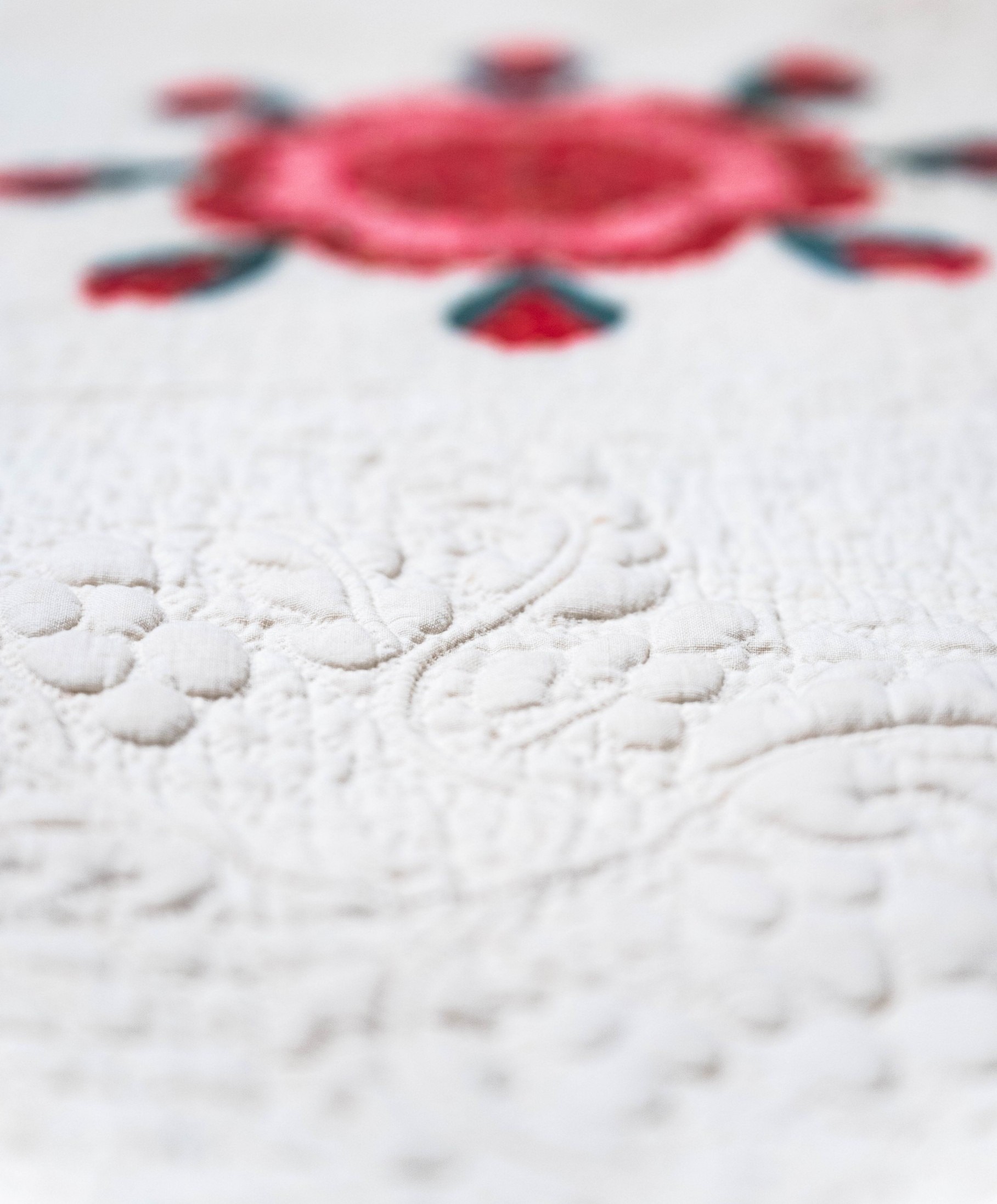
. . .
Most of these century-old brilliantly colored, exquisitely detailed, hand and machine-pieced, appliquéd, trapuntoed and embroidered quilts are decorative and were displayed, not used as blankets, in the home.
The installation was carefully planned to avoid causing damage to the pieces. A few quilts were placed on period antique beds. The rest were displayed, not hung or attached, simply “resting” (my word) on very large custom-made slant boards. Contemporary quilts are usually displayed on a pole inserted in a “sleeve” sewed at the top.
The boards were covered with non-bleached muslin, 9 x 9 foot squares that had been machine washed by staff with conservation soap and then air dried. These quilts were constructed from cotton, wool, silk, used clothing – fabrics passed down within the family and costly imported fabrics.
. . .
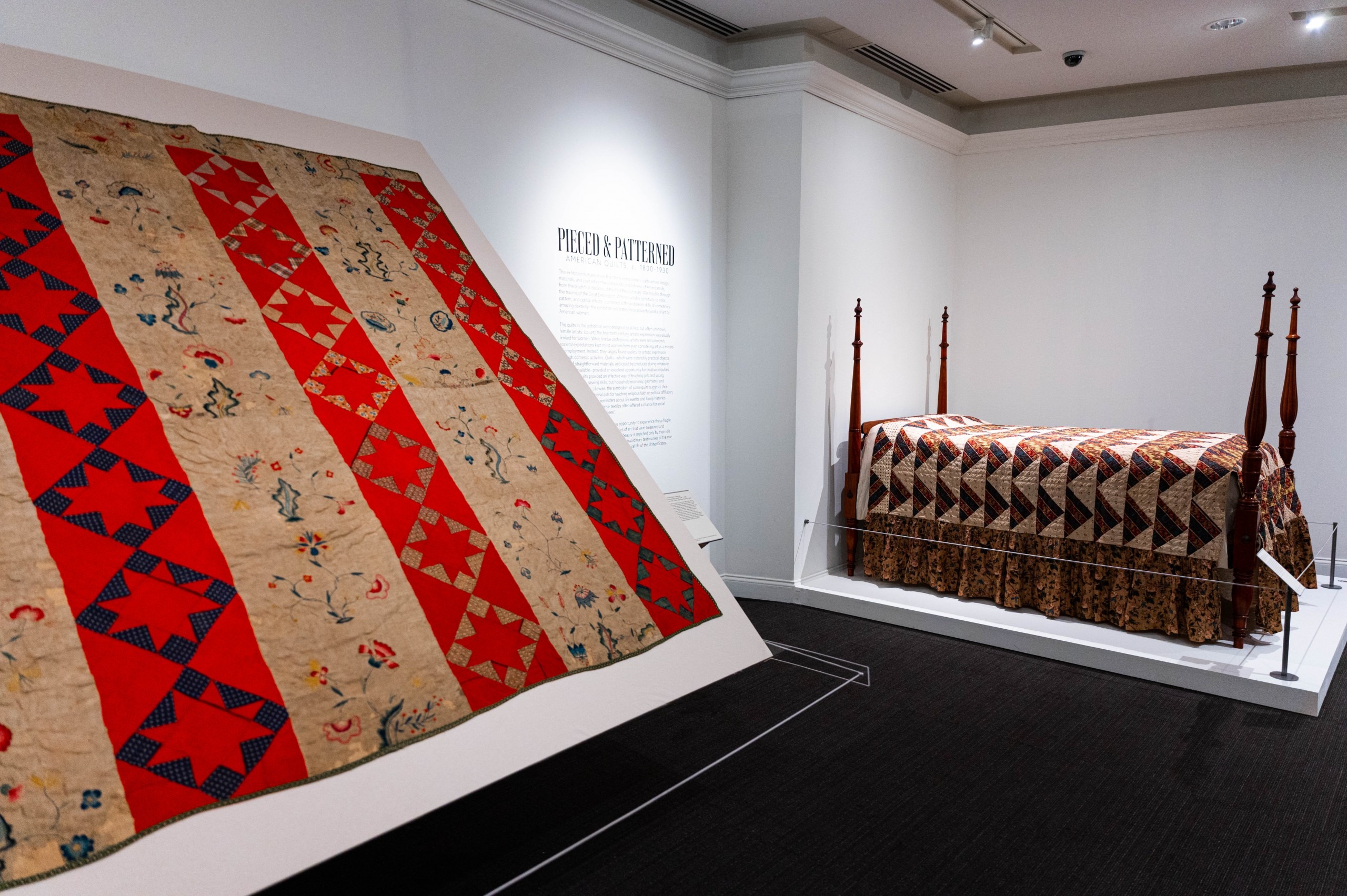
Dr. Thomas and Assistant Curator Erin Wilson say the quilts were considered prestige items, and each had its own story that was lost through the years. Most of the quilt makers in this exhibit are unknown. Quilts were a way the maker, usually a female, could showcase her artistic ability, math education and skills in hand sewing, embroidery and pattern design, they explain. The maker expressed herself politically through illustration, pattern, design and color. Use of fabrics, fine materials or imagery gives a hint of family wealth. Thomas and Wilson gave us a tour and each commented on the 32 quilts.
. . .
Interesting facts I learned during the conversation
and from the MFA exhibit brochure
. . .
- Early quilt makers (before patterns were widely available) had to know math, geometry and problem-solving to design and construct their work. Examples – Star of Bethlehem Quilt (c. 1840, attributed to a member of the Keeler family, Ridgefield, CT); the Blue and White Medallion Quilt (c.1850, the Age of Expansion); all the Crazy Quilts (c. 1900).
. . .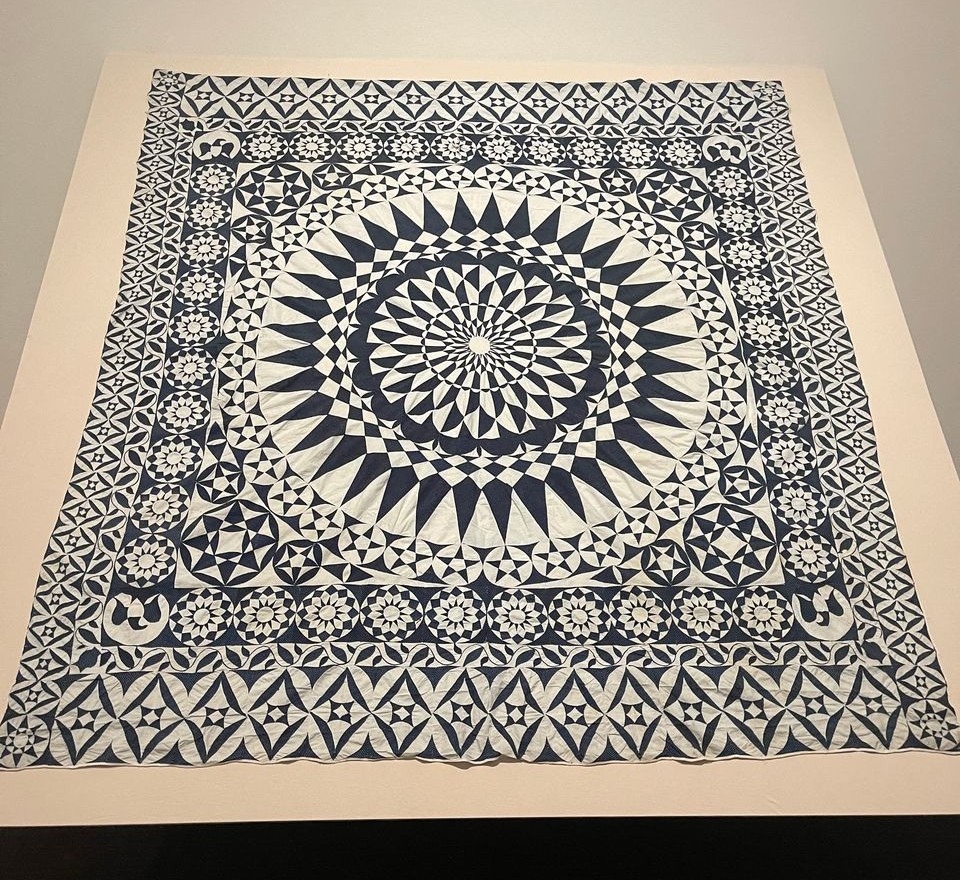
American, Pieced Quilt (“Blue Medallion Quilt”), c. 1850, Cotton with cotton thread, Collection of Linda McCormick Felts - Quilting was a practical means of education in the 19th century and a social activity for young women.
. . .
- Political views and patriotism. Examples: Blue and White Medallion Quilt (eagles in four corners); American Flag Quilt (c. 1912-1920); Whig’s Defeat (c. 1860-1880); Vases with Flowers Quilt (Whig Rose motif).. . .
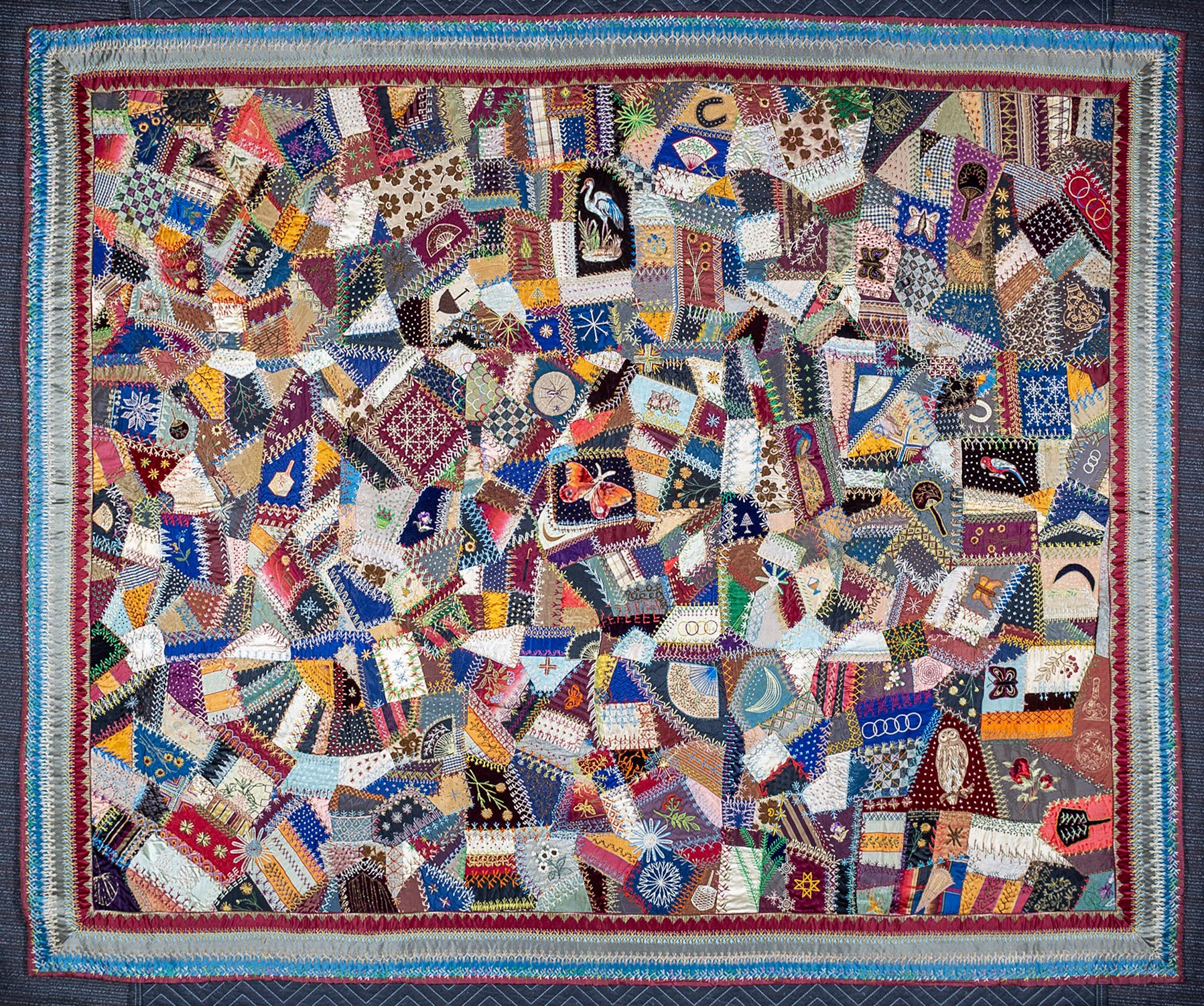
American, Crazy Quilt, c. 1890, Various textiles, On loan from the collection of William and Norma Roth 
Crazy Quilt (detail) – photo by Emily Lee Stehle . . .
- “Crazy Quilts,” so-called because of the seemingly random crazy placement of quilting pieces, became wildly popular in 1900. Ten years later, they were passé.
. . .
- Quilts are mementoes. Mourning Quilt (c. 1850) memorializes the tragic early passing of children in a woman’s care and includes images that signify death and loss. The scenes showing a reunion in the Paradise Garden Afterlife are quiet and calming, not whimsical but still charming. Certainly not morbid. You’ll see willow trees, pairs of birds, the peacock, deer, other animals and tombstones under the trees, beautifully executed fine embroidery including unusual buttonhole or blanket stitching (not seen before in quilts) in a peacock’s tail. This quilt, Dr. Thomas says, is among his top 3-4 favorites in the exhibit. It is my favorite.
. . .


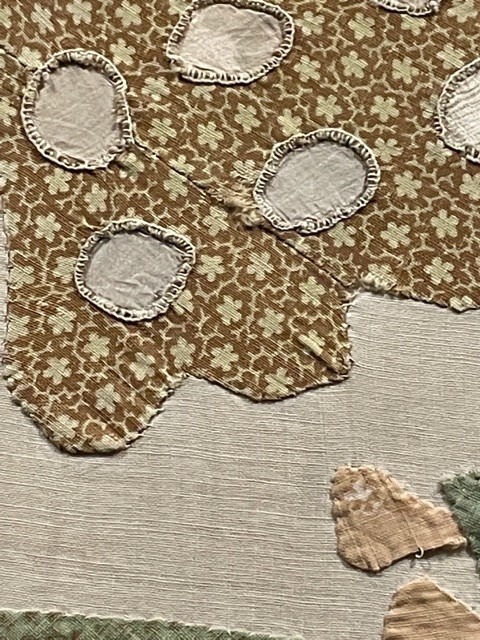
. . .
Erin Wilson selected a memory quilt as a favorite because of its unusual crewel work. The maker of the Touching Stars Variant Quilt (c. 1880) took strips of 1750s linen crewel work (most likely from a dress) and paired them with strips of common red wool piecing. The red wool may have been recycled from another item of clothing.
. . .

. . .
6. “Astonishing Construction,” termed by Wilson while describing the quilts. A standout – The Blue and White Medallion’s striking two-color palette and broad range of motifs give it a WOW factor. The stunning design features a large intricately detailed starburst, rising sun variants, an eagle in each of the four corners and a vine border. Two people are believed to have made this quilt because of the different knots used in the stitching. It is also a “top,” an unfinished quilt.
. . .

7. There is a fascination in solving a mystery behind a quilt. We can surmise much by carefully examining a quilt (stitching, embroidery, fabrics used, color and design pattern) and oral history to determine when, where or why it was made. But sometimes one mystery is never solved. We might not ever know the name of a quilt’s maker or makers.
. . .
My Thoughts
. . .
• Pieced + Patterned: American Quilts is a history and art exhibit. If you’re interested in art and design, you’ll get it. If you’re a quilter, collector or into “fiber,” you’ll definitely love it.
• The makers who created these traditional woman’s work quilts a century or more ago would be considered talented fiber artists in today’s world.
• Many of these quilt designs might have been considered revolutionary for the time. Today, they are reminders of timeless design and precursors of modern and pop art. Examples – Snake Trail Quilt, c. 1930, active Florida.

• The Postage Stamp Quilt, c. 1890, reminds me of my Ms. Blue aka the Blue Monster hanging wall piece in the Creative Pinellas Emerging Artists Show in July.


• I enjoyed learning about the general history of quilts and the 32 in this collection. What’s more, this exhibit features women’s work exclusively. It’s one way (somewhat hidden) we can discover and learn how women lived in that time. Their quilts were a showcase for their artistic accomplishments and today they illustrate, and can be used to study, the roles women played in the political, social and cultural life in America.
Congratulations and thanks, MFA for your first quilt exhibit. Hope it won’t be the last!
. . .
Fiber art fans can also experience
Stitching History from the Holocaust
Through January 2 at the Florida Holocaust Museum
Exploring the life and work of Hedwig Strnad, a gifted dress designer murdered in the Holocaust, featuring recreations of Hedy’s dresses from precious 1930s sketches.
Details here





